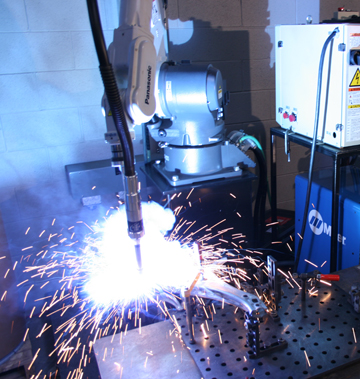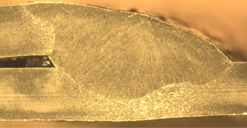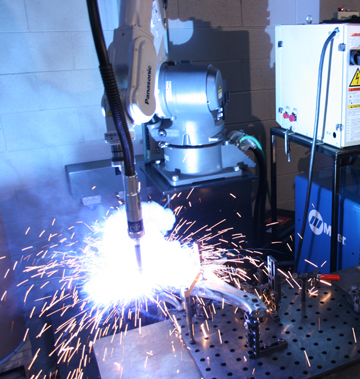Galvanized Steel Paired with Metal-Cored Wire Offers Benefits in Automotive Manufacturing
Galvanized steel is becoming an increasingly common material in automotive manufacturing because of the numerous benefits it offers. The material allows for the manufacture of lighter-weight vehicles without sacrificing the strength, corrosion resistance or the life span of the vehicle.
Reducing overall vehicle weight is a challenge the automotive industry will continue to face, due to the Corporate Average Fuel Economy (CAFE) regulations intended to improve the average fuel economy of cars and light trucks sold in the United States. While CAFE regulations were first enacted by Congress in 1975, increasingly stringent standards recently issued by the U.S. Department of Transportation and the U.S. Environmental Protection Agency require average fuel economy to be the equivalent of 54.5 mpg for cars and light-duty trucks by model year 2025.
The ability to fabricate more parts with galvanized steel helps automotive manufacturers reduce total vehicle weight by hundreds of pounds in some cases, which in turn helps them meet the increasingly strict fuel economy requirements. The ability to design thinner parts can also result in cost savings for manufacturers, since less material is being used.

steel can help manufacturers increase productivity and improve quality.
However, welding galvanized steel does pose some challenges. Because the material typically is thinner, there can be an increased potential for burn-through. Also, the zinc coating of galvanized steel can contribute to weld defects such as porosity, both on and below the surface of the weld.
Metal-cored wire formulated specifically for galvanized steel can address these challenges. This type of wire is capable of providing faster travel speeds at lower temperatures. Combined with a Pulsed Gas Metal Arc Welding (GMAW) process, in particular, it can help improve productivity and efficiency on this material, while also producing high weld quality.
Robotic welding is the standard method for most welding applications in automotive manufacturing because of the speed it offers, so this process pairs well with metal-cored wire and the faster travel speeds necessary for welding galvanized steel.
The basics of galvanized steel
The properties of galvanized steel make it a good choice for many automotive manufacturing applications. Galvanized steel has a protective layer of zinc on its surface, so the material offers excellent corrosion resistance and high strengths, even at thinner gauges such as 1 millimeter. Galvanized steel also is more cost-effective than a base metal like aluminum, especially when the application calls for using a lot of the material.
Because of these properties, many automotive manufacturers are converting to galvanized steel for more applications. In the past decade, galvanized steel may have been associated with automotive body skins of less than 1 millimeter, but today use of the material is expanding into other structural components such as frames, suspension and engine cradles.
There are different types of galvanized steel, all with their own characteristics and recommended applications. Overall, each present similar challenges, although to varying degrees.
The main challenges of welding galvanized steel
The thinness and zinc coating of galvanized steel are characteristics that provide many benefits, but they also can be the source of additional problems such as burn-through and porosity. Should these issues arise, manufacturers risk sacrificing quality and productivity, which can adversely affect their competitive edge and their bottom line.
Surface porosity on this material is a common issue that is regulated by American Welding Society (AWS) standards. See the item below for the AWS D8.8 2007 regulations regarding the porosity requirements, both surface and subsurface or internal. It is typically a two-step process to determine the internal porosity, first requiring an x-ray of the weld and then applying image analysis using contrast analysis to quantify the amount of porosity as a percentage. These weld defects could lead to catastrophic failures later in time, so addressing both types of porosity is important.
The travel speed used during the welding process directly impacts the presence of porosity. The faster the travel speed, the faster the weld pool tends to freeze, which can be especially troublesome since zinc vaporizes at a much lower temperature than steel melts. The temperature differentiation can lead to gas pockets becoming trapped because the weld solidifies before the zinc gas can escape.
In addition to the common issue of porosity, welding galvanized steel presents other challenges, including:
-The potential for burn-through due to the thinness of the metal, a challenge that can cost a manufacturer time and profit — in the form of lost product — should this defect occur.
-Spatter, which not only can adhere to the part, requiring post-weld cleanup, but also can adhere to tooling, leading to damaged sensors or clamps in the robotic system. Spatter is typically the result of the shorter arc lengths associated with Constant Voltage (CV) modes of welding.
-The presence of silica islands in the weld, especially those that may break free after the e-coat or paint process, or those that reside in the toes of the weld.
The benefits of metal-cored wire and Pulsed MIG
Pairing a Pulsed MIG welding process with metal-cored wire designed specifically for galvanized steel can help combat or prevent many of the challenges and issues associated with welding the material. The combination also offers marked improvements over the speeds and performance of solid wire, since one of the greatest advantages of metal-cored wire is its high deposition rates.
Hotter and faster are the keys to addressing many of the challenges when welding galvanized steel. It’s essential to keep a balance in the time/temperature relationship to successfully weld this material. Metal-cored wire is a type of tubular wire consisting of a metal sheath filled with metallic powders, alloys and arc stabilizers. As opposed to solid wire, metal-cored wire carries higher current densities (at equivalent amperage settings), making it possible to put more weld metal in a joint in less time during the welding process. Those faster travel speeds make metal-cored wire a frequent choice for robotic welding applications, like those found in automotive manufacturing. Achieving the same weld quality with solid wire would require much slower welding speeds and with it, higher heat input and potentially, burn-through.

MIG welding offers marked improvements over the
speeds and performance of solid wire, since one of
the greatest advantages of metal-cored wire is its
high deposition rate and a smooth, clean weld bead.
Recent advancements in metal-cored wires, specifically some carrying the AWS classification E70C-GS, provide significant advantages for welding galvanized steel. These wires feature formulations that allow them to weld with a direct current electrode negative (DCEN) or straight polarity. Operating in straight polarity offers distinct advantages when welding thin gauge galvanized steel, including:
-A softer arc penetration that prevents burn-through on thinner gauged material.
-An improved penetration profile.
-Sufficient arc energy to vaporize the galvanized zinc coating, which minimizes surface and subsurface porosity.
The formulation not only results in higher deposition rates, but also in good gap-bridging capabilities and a high strength deposit that maintains excellent ductility and impact toughness.
Like other metal-cored wires, the wires designed for welding galvanized steel also feature arc stabilizers that help improve metal transfer from the wire to weld, effectively reducing spatter and the need for post-weld cleaning or slag removal, which could slow down overall throughput.
The new metal-cored wires formulated for galvanized steel are designed to weld at 40 inches per minute in robotic applications, compared to 23 or 25 inches per minute for solid wire. The faster travel speeds and lower defect rates offered by the wire can help automotive manufacturers increase throughput, reduce capital expenditures related to rework and save time and money.
Increase productivity and reduce costs
When choosing a filler metal, it’s important to consider the application and material thickness being welded. Weld quality and porosity requirements — and how specific types of filler metals impact those issues — also are important considerations.
In many applications, the new options in metal-cored wire designed for use with galvanized steel can help manufacturers increase productivity, improve quality and maximize the benefits the material offers in automotive applications.



